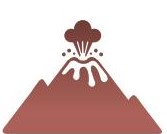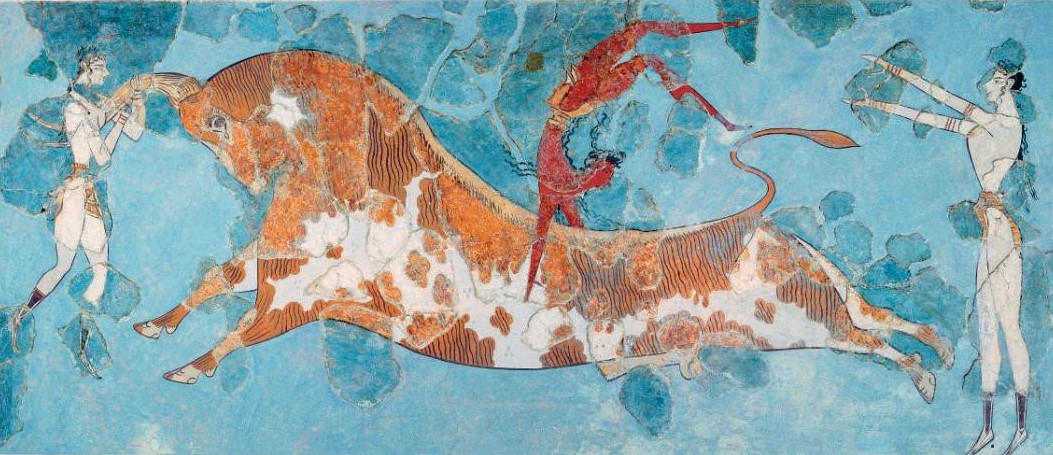1.1 Mysterious Minoans
The fascinating thing about history is often what we don’t know. Though we know the Mycenaeans overtook the Minoans, we don’t know for sure what caused their own violent end. Along with the Minoans, the Mycenaeans helped lay the foundation of Greek civilization.
After copying Minoan culture, the Mycenaeans conquered the Minoan people.

ANCIENT DISASTER
Around 1600 B.C., a volcano called Thira (THIH-ruh) erupted on an island 70 miles north of Crete. The eruption destroyed most of the island and caused death and destruction across the Mediterranean. Scholars disagree about whether this eruption caused the decline of Minoan civilization, but this is one possibility.
MINOAN CIVILIZATION
Historians trace the origins of Greek civilization to Crete, a mountainous island about 150 miles off the coast of mainland Greece. Neolithic farmers settled there around 7000 B.C. and agriculture flourished. By 2000 B.C., a sophisticated Minoan (mih-NOH-uhn) civilization had emerged, centered on cities governed from magnificent royal palaces.
Though the Minoans left behind written records, historians cannot read their language. Their knowledge of Minoan civilization is pieced together through archaeology and the writings of ancient Greek historians. There are also many myths about this civilization. Myths are very old stories told to explain events or to justify beliefs and actions. The word Minoan comes from a mythical Cretan king named Minos (MY-nuhs). According to the myth, Minos built a labyrinth (LAB-uhrinth), or maze, beneath his palace. A monstrous Minotaur (MIHN-uhtawr)— half man, half bull—lived in this labyrinth and was offered regular sacrifices of unlucky humans. Unlikely? Perhaps, but archaeological evidence confirms that a powerful Minoan king built a labyrinth-like palace, and Minoans did in fact worship bulls and perform sacrifices.

CITIES AND CULTURE
The Minoans grew wealthy through trade across the Mediterranean. One of the Minoans’ strengths was that they were expert sailors. Their well-built ships carried olive oil, wine, cloth, pottery, and metalwork to Greece, Egypt, Cyprus, and Spain. The Minoans returned from trading voyages with important raw materials , or substances from which other products are made, such as tin, gold, pearls, and ivory. Minoans spread their culture throughout Greece and along the coasts of the Aegean (ee-JEE-uhn) Sea. Their strong navy controlled the seas, making the Minoans feel so safe they did not build city walls.
The great palace at Knossos (NAWsuhss) dominated Crete. The size and complexity of the palace may have encouraged some people to believe it was Minos’s labyrinth. Home to almost 20,000 people, Knossos was more like a city than a palace. It was the center of Minoan culture, religion, and economy. The palace included a central courtyard for ceremonies, hundreds of rooms,and even advanced plumbing. It also provided workshops for Minoan artisans and storerooms for surplus crops, such as grains. Minoans worked to support the palace and enjoyed a relatively prosperous life.
Minoan religion was polytheistic, which means that people believed in many gods and goddesses. Lifelike Minoan wall paintings suggest forms of worship involving bull-leaping, boxing, wrestling, and dancing as well as sacrifices to pacify the gods. Mysteries surround the end of the Minoans. Around 1500 B.C., Minoan civilization declined sharply and its palaces fell into ruins. Possible causes for their collapse include natural disasters such as earthquakes, tidal waves, or volcanic eruptions. Some historians think all three factors—as well as an invasion by people from mainland Greece—contributed to the Minoans’ decline. By 1450 B.C., a new civilization would overtake the Minoans.
| 1. READING CHECK What were some of the traits of the earliest civilization in ancient Greece? |
2. DRAW CONCLUSIONS What does the great palace at Knossos reveal about the Minoan civilization? |
3. ANALYZE CAUSE AND EFFECT How did trade help the Minoans develop wealth? |
